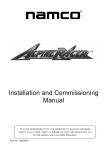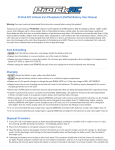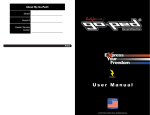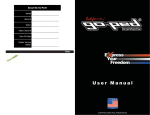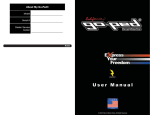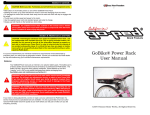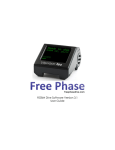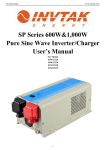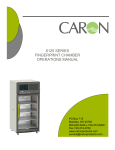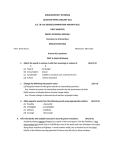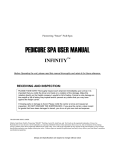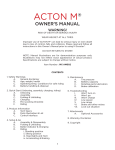Download Kooper user Guide
Transcript
Kooper® User Guide December 2010 Copyright Kooper® Technical details with regard to the information and figures in this User Guide are subject to change. Thank you for choosing the Kooper®. Please follow the safety instructions, when operating the Kooper®. Failure to read, understand, and follow the safety instructions contained in the User Guide may result in serious injury and/or death. Kooper user Guide www.Kooper®scooter.com Page 2 Table of Contents Warranty and Notifications .................................................................................................... 5 Important Safety Instructions ................................................................................................ 6 About this Manual ................................................................................................................... 7 Why you should read this manual: ....................................................................................................... 7 A SPECIAL NOTE FOR PARENTS ................................................................................................... 7 Introducing the Kooper®™ ................................................................................................... 8 Structure ............................................................................................................................................... 8 Notes ................................................................................................................................. 9 Performance ...................................................................................................................... 9 Specifications: ...................................................................................................................................... 9 Safety ...................................................................................................................................... 10 Safety Equipment ............................................................................................................................... 10 Helmets............................................................................................................................ 10 Protective pads ................................................................................................................ 10 Shoes ............................................................................................................................... 10 Clothing............................................................................................................................ 10 Reflectors......................................................................................................................... 10 Mechanical Safety Check ................................................................................................................... 11 Nuts, bolts, and structural: .............................................................................................. 11 Tires and Wheels: ............................................................................................................ 11 Brakes: ............................................................................................................................. 11 Scooting Safety .................................................................................................................................. 11 Know Your Scooter .......................................................................................................... 11 Ride Within Your Abilities ................................................................................................ 11 Rules to Scoot By: .............................................................................................................................. 12 Stunts, Wheelies, or Jumps ............................................................................................. 12 Wet Weather Riding: ....................................................................................................... 12 Assembly................................................................................................................................. 13 Adding Seat + Rack or Child Carrier ................................................................................................. 13 Adding a bag ...................................................................................................................................... 13 Folding Feature .................................................................................................................................. 14 Adjustable Handlebar ......................................................................................................................... 14 Operations .............................................................................................................................. 15 Starting your Kooper®™ ................................................................................................................... 15 Kooper user Guide www.Kooper®scooter.com Page 3 Charging “Lithium Ion” (Li-Ion) models ........................................................................................... 15 ELECTRICAL HAZARD........................................................................................................ 16 Fuel Gauge (Throttle) ......................................................................................................................... 16 Safety Switch ..................................................................................................................................... 16 Batteries ............................................................................................................................................. 16 Section 5: Controls ................................................................................................................ 17 Maintenance and Parts ......................................................................................................... 18 Service and Maintenance Schedule .................................................................................................... 18 Adjustment ............................................................................................................................. 19 Brakes ................................................................................................................................................ 19 Brake lever and cable ...................................................................................................... 19 Fine Adjustment .............................................................................................................. 19 Major Adjustment ........................................................................................................... 19 Wheels................................................................................................................................................ 19 Operator Tips to Improve Performance ............................................................................. 20 Battery Care ..................................................................................................................... 20 Riding surfaces to avoid................................................................................................... 20 Weather Conditions to Avoid: ......................................................................................... 20 Hot or Cold....................................................................................................................... 20 Clean is good.................................................................................................................... 20 Kooper user Guide www.Kooper®scooter.com Page 4 Warranty and Notifications Kooper® ltd. expressly warrants that the Kooper®™ is free from defects in material and workmanship under normal operating conditions and according to proper use for a period of 12 month from the date of original purchase. Normal operating conditions require routine care and maintenance by the purchaser of the product. Proper use means that the Kooper®™ is to be used only in the manner intended with proper safety equipment described in this guide. You can also use the mounted child seat in the manner intended and according to the limits set forth in this guide. Kooper®™ is intended for use only with the proper safety equipment on smoothly paved, safe, non-oily surfaces in accordance with local regulations. In express consideration for purchasers execution of the limited warranty and liability agreement, Kooper® will repair or replace any part or component, other than tires, of the Kooper®™ free of charge to the original purchaser who registers his/her product under the warranty program. Warranty service can be obtained by calling your local dealer at ________________ and following the instructions given by the service representative. Shipping costs will be at the purchasers’ expense. This warranty does not apply to tire wear, operation under abnormal conditions or damage to the vehicle brought on by improper use. Racing, competitive or commercial use, or modification of the product shall void this express limited warranty. Purchaser herewith acknowledges: (a) Kooper® assumes no liability for any misuse of any of Kooper®™. (b) Under this limited warranty and liability agreement Kooper® shall have no obligation and the purchaser or user shall have no remedy against Kooper®, its officers, agents or assigns for any damages, including without limitation, incidental, consequential, special, punitive damages arising from direct or indirect injury to person or property, or any other loss, whether or not occasioned by negligence, or otherwise, on the part of Kooper®. (c). Purchaser acknowledges that there is an inherent risk in the electrical scooters such as the Kooper®™, and herewith assumes the risk of any injury arising from operation of any Kooper® transportation product. Original owner will indemnify and hold Kooper® harmless and will take full responsibility for conveying all safety warnings, instructions, and limited warranty if unit is sold, lent, or otherwise transferred to other persons and will indemnify Kooper® from any claims against it for original owners’ failure to do so. THE EXPRESS LIMITED WARRANTY DESCRIBED ABOVE SHALL BE EXCLUSIVE AND THERE IS NO OTHER WARRANTY OR LIABILITY, EXPRESS OR IMPLIED, ARISING BY LAW OR OTHERWISE AND WHETHER OR NOT OCCASIONED BY SELLER’S NEGLIGENCE. THERE IS NO IMPLIED WARRANTY OF MERCHANTABILITY OR FITNESS FOR A PARTICULAR PURPOSE. THERE ARE NO WARRANTIES WHICH EXTEND BEYOND THOSE EXPRESSLY STATED HEREIN. NOTICE: Some countries do not allow the exclusion or limitation of incidental or consequential damages and some countries do not allow limitation on how long an implied warranty lasts, therefore, some of the above limitations may not apply to you. Kooper user Guide www.Kooper®scooter.com Page 5 Important Safety Instructions P LEASE ACKNOWLEDGE THAT YOU HAVE READ AND UNDERSTOOD EACH WARNING: _ This device does not conform to US Federal Motor Vehicle Safety standards and is not intended for operation on public streets, roads or highways. Use the Kooper®™ only on streets, roads, sidewalks and places where its use is permitted by law. _ Safety helmet, goggles, gloves, elbow, and knee pads, appropriate shoes, and bright clothing must be worn while operating this device to reduce potential of injury. _ Do not operate this device in traffic, or on frozen, oily or unpaved surfaces. Wet and icy weather impairs traction, braking, and visibility. Avoid uneven surfaces, chuckholes, surface cracks, obstacles and night or conditions of darkness or poor visibility (i.e. fog). _Where riding at night is allowed, never ride without switching on the Kooper®™'s lights. _Do not ride the Kooper®™ on stairs or through revolving doors. _ Never carry passengers and objects that can hinder your abilities to safely operate your vehicle. _Check all fastening elements thoroughly prior to using the device to make sure they are tight (bolts, load bearing addition, mounted child seat, folding mechanism for stem, etc.). _ Pregnant persons should not use this product. _ Never use alcohol or drugs before or while operating this device. They slow reaction time and impair judgment. _ This product should not be used by minors without adult supervision. _ High speeds, jumps and trick maneuvers are dangerous and could result in loss of control and other accidents. Therefore, The Kooper®™ should not be operated to perform racing, stunt riding, or other maneuvers, which may result in loss of control, or may cause uncontrolled operator actions or reactions. _ When accelerating or climbing hills, you will need to lean forward, under braking conditions you will need to lean back, to keep wheels in contact with the ground. _ Never permit a guest to use this device unless the guest has read the user manual. _ I agree to provide my guest with helmet, safety goggles, elbow pads, and knee pads. _ This product should not be used by persons unwilling or unable to take responsibility for their own actions. Individuals with the following conditions are cautioned not to operate Kooper®™. Those with: Heart conditions; Pregnant women; People with head, back, or neck ailments, or prior surgeries to those areas of the body; People with any mental or physical conditions that may make them susceptible to injury or impair their physical dexterity or mental capabilities to recognize, understand, and perform all of the safety instructions and to be able to assume the hazards inherent in unit use. _ Read all additional warnings and instructions in user manual before operating this product. _ Adults purchasing this unit for children, inclusive but not limited to a Parent or Guardian, assume direct liability for injury to the child, or to third parties to whom the child entrusts the vehicle. _The Kooper®™ is not designed and should not be operated by any person under the height of 150cm (5’0”) and above the height of 200cm (6’5”). _The Kooper®™ should not be operated with a weight (person and load) of more than 150kg (lbs), including the weight of the rider. The Kooper®™ should not be operated by any person under the age of 16, and outside of North America under the age of 14. This is the case as long as there is no legislated higher limit in your jurisdiction. _Do not, on your own, modify the Kooper®™ from the manufacturer's original design and configuration. All repairs and/or modifications should be performed by a licensed Kooper®™ dealer or trained technician. Any opening, modifying or tampering with the device will immediately void the warranty. _ I herewith promise not to entrust this vehicle to any child under the age of 16 (Sixteen) years of age. Kooper user Guide www.Kooper®scooter.com Page 6 About this Manual Why you should read this manual: This manual was written to help you understand the operation and maintenance of your vehicle. It’s important for you to understand your new scooter, its features and operations so that from your first ride you will get the most from your new scooter and form proper habits to keep it maintained for optimum performance and safety for many years to come. Keep this manual. Refer to it often and use it to instruct other users. If you loan out your Kooper®™ also loan them this manual. It is also important that your first ride on a new scooter is taken in a controlled environment, away from vehicles, obstacles and other hazards. Scooting can be a hazardous activity even under the best of circumstances. Proper maintenance of your scooter is your responsibility as it helps reduce the risk of injury. This manual contains many “Warnings” and “Cautions” concerning the possible consequences of failure to follow instructions, perform maintenance, or inspect your scooter. Any fall can result in serious injury or even death, so operating within the guidelines outlined in this manual will help reduce those risks. ATTENTION: The status of the Kooper®™ as a “motor vehicle” varies from country to country and is subject to drivers licensing, insurance requirements and registration. You should check with a reliable authority in your country to see if the Kooper®™ must be registered as a motor vehicle. Your insurance policies may not provide coverage for accidents involving the use of this vehicle. Check with you your insurance company or agent. The recommended age and minimum weight for the Kooper®™ is 16 years of age or older and 100 pounds, but this is subject to the physical coordination of the rider, the ability of the rider to wear protective gear, use good decision making ability, and to take responsibility for their own actions. In this user guide, the indicates a warning. The indicates a cautionary note. Please pay attention to the recommended precautions and warnings. A SPECIAL NOTE FOR PARENTS It’s a tragic fact that most children are more likely to have an accident. As a parent or guardian, you bear the responsibility for the activities and safety of your minor child. These responsibilities include the need to make sure that the scooter which your child is riding is properly fitted to the child; that it is in good repair and in safe operating condition; that you and your child have learned, understand and obey not only the applicable local motor vehicle and traffic laws, but also the common sense rules of safe and responsible scooting. As a parent read this manual and go over all key points with your child before letting your child ride the scooter. Kooper user Guide www.Kooper®scooter.com Page 7 Introducing the Kooper®™ The Kooper®™ is an innovative electric scooter that is made of the highest quality materials. It is the result of 5 years of development and engineering and the Kooper®™ was built to be a ZERO maintenance vehicle for human transportation. The Kooper®™ uses a brand new, smart, brushless, high-power DC motor, that has an energy saving, highly efficient programmable controller. The Kooper®™ is powered by advanced lithium polymer batteries, stored in the scooter's battery box. Full charging of the batteries takes four to six hours. You can charge the batteries whenever you like, for example, if you take the Kooper®™ to work, you can charge the batteries in your office. The rear shock absorber, built into the scooter's main frame, makes it amazingly comfortable for any type of road. The Kooper®™ also has a front absorber for further comfort and smooth riding. The Kooper®™ is relatively light and it can be easily folded and carried or placed in your car trunk, home, caravan or yacht. The Kooper®'s maximum speed is 33 kmh for a range of 35 km, when fully charged. The speed and range of the journey change from country to the country depending on state laws. The speed and the range are influenced by the rider's weight and road conditions. Structure The Structure of the Kooper®™ Kooper user Guide www.Kooper®scooter.com Page 8 Notes The batteries are stored in the scooter tray. Do NOT disassemble! The seat and rack unit is optional. You can add it or remove it as needed. Handle Bar The throttle lever and safety switch are located on the right handle. The horn and light buttons are located on the left handle. Performance When fully charged, the driving range is 30 km, depending on the rider's weight and surface conditions. Maximum speed: 33 km per hour. Speed can be limited to local legal limits. Maximum load weight: 150 kg (330 lbs) including the rider's weight. Specifications: Power Power Supply Wheel Size Frame Material Place of Origin Shock Absorbers Additions Dimensions Board Acceleration Lights Alarm Warranty Kooper user Guide 251-350 W Lithium Polymer 10 AH LifeP04 48V-2 x 24V Batteries 12" alloy wheels Aluminum Alloy T6-6061 Israel Front 3" and back 4" Seat with Rack; Seat with child seat Length: 134cm Width: 35 cm Handlebar width: 57 cm Height: 100-115 (adjustable height) Wood Controlled acceleration, with safety button. Built-in front and rear lights, with on/off button Electronic alarm with 2 remote controls 12 months Voltage Certification 48 V CE, TUV Motor Brushless Brand Name Model Number Kooper® KP3110 Weight <52 kg Brakes Charging time Mud guards Front and rear disks 4-6 hours for full charge Button located on handlebar Front and rear. Tire pressure 40 PSI Horn www.Kooper®scooter.com Page 9 Safety Safety Equipment Many States or regions require specific safety devices and/or equipment. It is your responsibility, prior to riding the Kooper®™, to familiarize yourself with laws of the state or region in which you ride and to comply with all applicable laws, including properly equipping yourself and your scooter. Helmets While not all States or regions require riders to wear approved protective head gear, common sense dictates that you should wear an approved helmet. Most serious incidences involve head injuries which might have been avoided if the rider had worn a helmet. Sivuv2 has a approved helmets, and can recommend one to suit your needs. Make sure that it fits correctly, is worn correctly and is properly secured. Refer to the owner’s manual provided with the helmet. Buckle Up! Always wear an approved helmet when riding your scooter. The helmet should be worn correctly as outlined in the owner’s manual. Failure to wear an approved helmet can result in a serious injury. Protective pads Elbow pads, knee pads, and wrist guards are not required by most states or regions. Again, common sense dictates that you should wear protective pads to help protect against injury. A good set of pads should fit comfortably, stay in position at all times and not have any excess strapping, Velcro®, or other protrusions to catch on anything that can cause you to lose control of your scooter. Shoes Your shoes should have good grip, protection, and support. Your shoes should have adequate strapping or laces so they stay on your feet. Make sure that laces or other strapping cannot catch or hang-up on any part of the scooter or other objects. Never ride barefoot or wear sandals when operating the scooter. Clothing Being seen is very important. Brightly colored, reflective helmets and clothing will help make riders more noticeable. Clothing should not be so loose that it can catch on moving parts or be snagged on other objects. E. Eye protection: Any kind of riding can involve airborne debris, dust, and bugs, so common sense dictates that you should wear protective eyewear with protective lenses. Reflectors Reflectors are important safety devices designed to reflect light in a way that helps to be seen. The reflectors are intended to enhance the visibility of the scooter but may not meet reflector requirements for your area. Do not remove the reflectors from your scooter. Removing reflectors may reduce visibility to others. Reflectors are not suitable for use as lights. Riding at dawn, dusk, or night is not recommended. Kooper user Guide www.Kooper®scooter.com Page 10 Mechanical Safety Check The Kooper®™ is intended to be a Zero maintenance vehicle. Nevertheless, here is a simple procedure you should get in the habit of before you get on your scooter: Nuts, bolts, and structural: Due to vibration, nuts and bolts can become loose. Make sure that all fasteners are securely fastened and tighten if necessary. Pick your scooter off the ground a few inches and bounce it off the ground. Do a quick visual and tactile inspection of the whole scooter. Make sure you look at all visible nuts, bolts and structural welds. If anything sounds, feels or looks loose or shows signs of stress then replace, or secure them. Inspect unit before each use. Make any required adjustments, and replace or repair any item that may need it. Tires and Wheels: Check that pneumatic tires are properly inflated at least every week to 10 days. The recommended PSI is 40. Checking PSI using a tire pressure gauge is recommended but you can also bounce your weight on the scooter and compare tire deflection to how it looks when you know the tires are properly inflated. Spin the wheels and check that the tires have not yet reached the wear marks on the tires, have ripped, torn, or show any signs of distress, and replace as necessary. Make sure the wheels spin freely and true. If wheels wobble and/or rub the brakes then make proper adjustments before proceeding with the Mechanical Safety Check. Brakes: Squeeze the brake levers and check that they are getting proper contact with the disc. Full braking force is applied when you squeeze the lever and the lever cannot touch the handle bar or grip. The brakes should not interfere with the rotation of the wheel when not applied. Make sure that the brake caliper gets full contact with the disc. Make sure that all brake surfaces are clean and free of debris. Do not ride the scooter until the brakes are properly adjusted. Never ride with improperly adjusted brakes. Scooting Safety Be aware that like most sports, riding a scooter involves risk of injury and damage. By choosing to ride a scooter you assume the responsibility for that risk. This makes it extremely important that you know, understand, and practice the rules of safe and responsible riding. Scooting can be an environmentally useful, safe and fun way of reducing traffic congestion. Scooters are designed for recreational use only! They should never be used on public and offroads. Know Your Scooter Familiarize yourself with the scooter before you ride. Check the controls. Ride very cautiously until you become familiar with the way the scooter handles. Take turns slowly and give yourself extra stopping distance. Ride Within Your Abilities To control your scooter, you need to keep it upright and make it go where you want it to go. Press the throttle responsibly, never going faster than you can handle. Controlling direction, speed or balance can only be learned through practice. Below are a few things to help you. Kooper user Guide www.Kooper®scooter.com Page 11 Body Position: Stand firm but relaxed. Keep weight between the wheels. Don’t stand too close to the front or lean too far back. Shift your weight to the rear when applying brakes, and lean towards the front when accelerating. Keep feet apart for more stability. Turning: New riders tend to have more trouble turning than experienced riders do. The only way to make good safe turns is to practice. Always approach turns carefully. Braking: Front brakes provide most of your stopping power, but you will need to learn to adjust your center of gravity to maintain stability. Again, practice this at a safe speed until you are comfortable with this action. Areas to Ride: Ride in a safe place free of cars in an area which will not disturb other people or animals and has a clean dry surface. Rules to Scoot By: Always wear your safety gear Never ride under the influence of alcohol or drugs Learn the local laws and regulations Ride defensively Wear bright colored and/or reflective clothing Turn on the scooter's lights when riding your scooter at night or in conditions of poor visibility. Observe and yield the right of way Do not dart out of driveways or from between parked cars Stop at all stop signs/lights Be careful when checking traffic and don’t swerve when looking over your shoulder Only ride on sidewalks Avoid riding in bad weather, wet, muddy, icy conditions or when visibility is obscured Do not do stunts, wheelies or jumps. They will increase your chances of injury and damage to your scooter. You are sidewalks with others. Respect their rights, and be tolerant if they inconvenience you. Always yield right of way to pedestrians and animals. Ride in a way that does not frighten or endanger them, and avoid riding near them whenever possible. Keep your speed consistent with the conditions, and keep in mind that speed has a direct relation to control as well as component stress. You can carry a child only when using the Kooper®™'s mounted child seat. Be sure that the child's weight does not exceed the maximum safety limit of 35 kg. Never carry anything that can obstruct vision, or control of your scooter. The maximum weight for additional load is 50 kg. Everyone must be responsible for the environment, ride accordingly. Stunts, Wheelies, or Jumps The electronics in your scooter are sensitive to heavy vibration and shock loads. These stunts can be fun, but it puts incredible stress on everything. Riders who insist on jumping risk serious damage to their scooter and themselves. Wet Weather Riding: Riding in wet conditions is permitted, but should be done carefully. The Kooper®™ is waterresistant and the batteries are safe from getting wet under mild conditions. Wet weather impairs traction, braking and visibility, for riders and others. The risk of accident dramatically increases in wet conditions. Kooper user Guide www.Kooper®scooter.com Page 12 Assembly All models come completely and fully assembled so there is no assembly requirement other than an inspection of all components to insure that nothing was damaged during shipment. If you see any damage or stressed components then contact your local authorized Kooper®™ dealer for replacements or repairs to those components. Check the tire pressure, making sure that the tire is correctly inflated (40 psi). The only assembly required is when you add the seat (with or without a rack), mounted child seat or rack for carrying loads. Replace front or rear tires when tread is worn within 1/16" tread depth, or if obvious tire damage has occurred. Adding Seat + Rack or Child Carrier The Kooper®™ can carry loads of up to 150 kg (lbs), including the weight of the rider. The scooter comes with the option to mount a seat with a rack or a seat with a child carrier. To mount an addition: 1. Remove the cover located at the back of the scooter's board. 2. Mount the required addition using the nuts and bolts supplied with the addition. Be sure to tighten the nuts and bols to prevent the additions from getting loose during use! Adding a bag You can add a bag to the scooter's handlebar using tapes. Kooper user Guide www.Kooper®scooter.com Page 13 Folding Feature Your Scooter is equipped with a folding feature for easy carrying and stowage. To fold: 1. 2. 3. 4. Turn the tubes located at the base of the “t” handle to free them. Slide them up until it completely exposes the hinge assembly Fold to the latching mechanism found at the back of the scooter's board. Reverse the process to lock handle bar in the riding position. Adjustable Handlebar You can adjust the height of the front handlebar. To adjust the height of the handlebar: 1. 2. 3. Turn the handle screws loose. Lift the handlebar to a new notch. Close the screws. Handlebar adjustment options Kooper user Guide www.Kooper®scooter.com Page 14 Operations Starting your Kooper®™ After completing the safety checks listed in this manual, you can use the remote to disengage the alarm and to start the motor. The Kooper®™ comes with two electronic alarm security system remote control units. The remote controls have four buttons: Turns off the motor. Sets the alarm. Disarms the alarm, but the engine remains off. Double-clicking turns on the engine. Locator sound to locate where you parked your scooter. Pressing the light switch on the left handlebar turns on both the front light and the tail light. Press the throttle's safety button to release the throttle (see "SAFETY SWITCH") and start riding. When riding at night or in rainy weather, be sure to turn on your scooter's lights. Charging “Lithium Ion” (Li-Ion) models Do not leave your unit on charge for more then 24 hours at a time. This will damage batteries and/or create a possible fire hazard. Note: Your unit uses “Smart Charger” technology and can be plugged into any standard 110v or the European standard 220V wall outlets. Do not operate the unit while charging. This poses a serious risk to the operator and can potentially damage the unit. The Kooper®™ has an onboard charger. It is recommended that you charge your scooter immediately after each use. Avoid letting your scooter sit unused for long periods of time with depleted batteries as this can damage the batteries and shorten the usable life span. In order to charge the batteries: 1. Remove the socket cover (A). 2. Plug the cord into the electrical outlet. 3. Plug the provided cord into the receptacle on the right side of the board's tray (B). The LED next to the socket indicates the status of the charge. When charging the LED is red. When fully charged the LED will change to green. It is safe, to leave the scooter plugged in for up to 24 hours. CHARGING WARNING: Though we anticipate none, and have encountered no safety problems while charging the Kooper®™ Li-ion polymer packs, there is always a remote possibility that unanticipated electrical or electronic discrepancies due to unintended uses and conditions could possibly cause a malfunction in the future without notice. Do all charging in a safe location where, should any unlikely safety issue arise in the form of smoke or fire, it will not be possible to damage property. Kooper user Guide www.Kooper®scooter.com Page 15 Note: The Battery Management System (BMS) that accompanies each Li-Ion battery protects the battery cells from over discharging and damaging the cell(s). Before the battery level can drop near damaging levels the BMS will “Shut Down” all power to the unit in order to protect the cells from possible harm. If this occurs inserting the charging cord and immediately removing it will RESET the system. ELECTRICAL HAZARD Never allow children to charge the battery. Battery charging must be done by adults only. Examine the power cord and connectors for damage each time you charge the battery. If damage is detected, do not use until you have replaced the damaged part. Charge you vehicle only in dry locations. Fuel Gauge (Throttle) There are three LED’s on the throttle control, which indicate the level of charge in the batteries. When the scooter is turned on and batteries are fully charged, all three LED’s will illuminate (green, yellow, red). After some riding, when the batteries are only partially charged the green LED will turn off, leaving only the yellow and red LED’s illuminated. After more riding, when the batteries are low the yellow LED will turn off and the red LED will begin flashing. This indicates that you are nearly out of power and time to recharge the batteries! If you continue riding after the red LED begins to flash, the scooter will slow and may eventually turn itself off automatically. This is a safety feature intended to protect the batteries from damage. If this occurs, fully charge the batteries and then the scooter will be ready to resume operation. The throttle is located next to the fuel gauge. Safety Switch The Kooper®™ includes a throttle cut-off switch as a safety feature. The safety switch is a Red push button located on the on the fuel gauge, on the right side of the handlebar, near the throttle . Push the button once before you start to ride to release the throttle. Press the button again when you are standing or you have ended your ride to lock the throttle. Batteries Your Kooper® uses internal Li-Ion polymer battery packs are 25.9V nominal at 10Ah from two packs,53.4v 10ah. The battery pan is a Factory sealed unit and should only be serviced by an authorized Kooper®™ dealer. The batteries will last a long time when properly maintained. These batteries do not have “memory” so it is OK to only partially discharge them before recharging them. Kooper user Guide www.Kooper®scooter.com Page 16 Section 5: Controls Before you ride - Familiarize yourself with how your Kooper®™ works. Familiarize yourself with which levers operate the brakes and throttle. Your new scooter may be different than other Motorcycles, ATV’s, bicycles, watercraft, etc. which you may have ridden before. The right side break lever operates the front wheel brakes. The left side break lever operates the back wheel brakes. It is recommended that you apply both breaks equally. If necessary, use the front wheel brakes as the low gravity center makes them work better under certain conditions. Do not lock the break! The remote control starts/turns off the scooter's motor. The horn and light controls are located on the handle. The red button is the throttle safety device. Use to turn off the throttle when standing idle. The handle bar or steering wheel supports the rider and steers the Kooper®™. Always use both hands on the handle bar, when riding. Do not stand or sit on the scooter when the kickstand is lowered. It is not intended to carry human weight and it will collapse under excess weight. Kooper user Guide www.Kooper®scooter.com Page 17 Maintenance and Parts The Kooper®™ is intended to be a Zero maintenance scooter. nevertheless, there are some issues that you need to be aware of. they are described in this section. Any modification of this unit voids the warranty, including but not limited to, using either wheels or tires not recommended by Sivuv2, attempting to enhance the speed or performance of the motor. Such modifications will create DANGEROUS AND HAZARDOUS conditions. You can purchase a scooter seat, rack and child seat from an authorized Kooper®™ dealer. Service and Maintenance Schedule Some service and maintenance can and should be performed by the owner, and requires no special tools or knowledge beyond what is in this manual. It is always a good idea to go over key points with an authorized Kooper®™ dealer who can further assist you with questions you might have and is the source for your parts. If you have trouble finding your closest authorized dealer you can find them by using our online dealer finder tool at www.sivuv2.co.il. Check the air pressure in your tires every week to ten days. It is recommended that you have an authorized Kooper®™ dealer perform periodic checkups. Typically, a dealer will suggest you bring it back for a 30 day checkup or after the first 5 to 15 hours depending on your riding style and geographic location and usage. Before every ride: "MECHANICAL SAFETY CHECK". During and After a long ride, exposure to water and grit, or every 100 miles: Clean the Kooper®™. After every long ride or hard ride or after ever 10 to 20 hours of riding: •Check all the control cables to ensure that they are securely attached to your Kooper®™ and that the levers are functioning normally. If you see rust, kinks, and/or fraying then have your authorized Kooper®™ dealer replace them. •Check the frame for any deep scratches, cracks, or discoloration. These are signs of stress-caused “fatigue” or overloading and indicate that a part is at the end of its useful life and needs to be replaced. •Check to make sure that all parts and accessories are still secure, tighten any which are not. As required: If any part fails your "MECHANICAL SAFETY CHECK" have those parts serviced immediately. Every 25 to 50 hours: Take your Kooper®™ to an authorized Kooper®™ dealer for a complete check up. Brakes, steering, bolts, bearings, and drive components should all be looked at and adjusted, replaced or repaired as necessary. Kooper user Guide www.Kooper®scooter.com Page 18 Adjustment Brakes Brake lever and cable Make sure the cable is not frayed or kinked in any way. Lever position can be adjusted for your reach on the controls, Cable adjustments are available at the brake lever and you can increase or take up slack by screwing or unscrewing the adjustment barrel. Side-pull caliper units fitted with side-pull calipers operate much like a standard bicycle side pull caliper brakes, with the exception that the wearing surfaces are incorporated into the tire rather brake pads. Fine Adjustment 1) 2) 3) Loosen the adjustment barrel locknut. Turn the adjustment barrel clockwise if brake rubs against the wheel, and counter clockwise if they are too far away. (Each side should have 1/16” to 3/16” spacing between caliper and wheel). Retighten the locknut. Major Adjustment 1) 2) 3) 4) Loosen the adjusting barrel clockwise until it bottoms out, then back it off 1 1/2 or 2 turns. Loosen the cable anchor nut. Squeeze the brake arms together and hold them so the brake remains against the tire (3 hands make a big deference). Pull out all the slack on the cable using pliers. While maintaining cable tension with the pliers and still squeezing the brake arms together, tighten the cable anchor nut. NOTE: It is not critical to have both sides of brake calipers strike the wheel at the same time. It is possible for one side to reach the tire first. The other side will eventually strike the tire and the caliper will then squeeze the braking surface to slow the Go-Ped®. If one side of your caliper drags the wheel then adjust by using a 10mm deep socket to loosen the 10mm nut used to attach the brakes from the back side of the calipers. Hold the brakes straight and retighten in place. The brake mounting bolts and nuts must be securely tightened to maintain proper braking. Wheels Replacing pneumatic tires and tubes: The tires and tubes are critical components requiring precise reassembly to insure proper alignments. An authorized Kooper®™ dealer using original parts should do this operation. Completely deflate wheel before wheel disassembly or any work on the wheel. Failing to do so can result in serious injury Kooper user Guide www.Kooper®scooter.com Page 19 Operator Tips to Improve Performance There are a lot of little things that an operator should do to unlock the full potential of the Electric Vehicle. In this section you will find some tips and advice intended to help you achieve that goal. Don’t get dragged down. Brakes and chain should not be dragging or preventing the wheel from spinning freely. There is a small amount of natural drag created by the drive components but making sure they are in working order, properly lubricated, adjusted, and in alignment, will help ensure you are not losing any performance. Rolling. Make sure you have the proper pressure in the tires. There is a PSI tire pressure rating on the side wall on the tire and you should try to keep your ESR tires at that pressure at all times. We have found it is safe to go as high as 10 PSI above the rating on the sidewall. This will further reduce the rolling resistance of the tires and increase the usable range, acceleration, and speed. DO NOT over inflate wheels more than 10 PSI above recommended levels market on the sidewall of the tire. Battery Care Letting the batteries sit in the unit with a depleted charge is harsh on the chemistry that makes them functional and will greatly reduce their usable life. So, it is best to get in the practice of keeping them charged whenever possible. Charge For Storage. Do not leave unit on a charge for more than 24 hours. Any longer and over charging can end up damaging the batteries or even create an potential fire hazard. If you plan to store the unit for more than a week you should first charge the unit fully then disconnect the charger to store and put the unit on a charge for a few hours once a month to insure the batteries stay “topped off”. Riding surfaces to avoid Your unit incorporates some very sophisticated and sensitive electronic components that do not like heavy vibrations or shock loads that is typically associated with riding on an unpaved/uneven surface or hopping down street curbing. The occasional unavoidable bumps are OK but try to avoid rough terrain whenever possible. Weather Conditions to Avoid: The Kooper®™ is water resistant and it is completely sealed from the elements so you can drive it in the rain or after a rain. Nevertheless, driving the unit through standing water, wet or muddy conditions runs the risk of severely damaging it. Hot or Cold Be aware of are extreme temperatures. The hotter the temperature the less efficient your unit will be so try to avoid operation on those very hot days. Also, avoid allowing your scooter to sit in freezing temperature as this could cause severe battery damage. Clean is good. This does not mean you cannot wash or clean your scooter. Clean the scooter with a mild soapy damp dish-towel and wipe it down. Just avoid heavy amounts of water that can end up finding its way to any of the electronics. Kooper user Guide www.Kooper®scooter.com Page 20




















